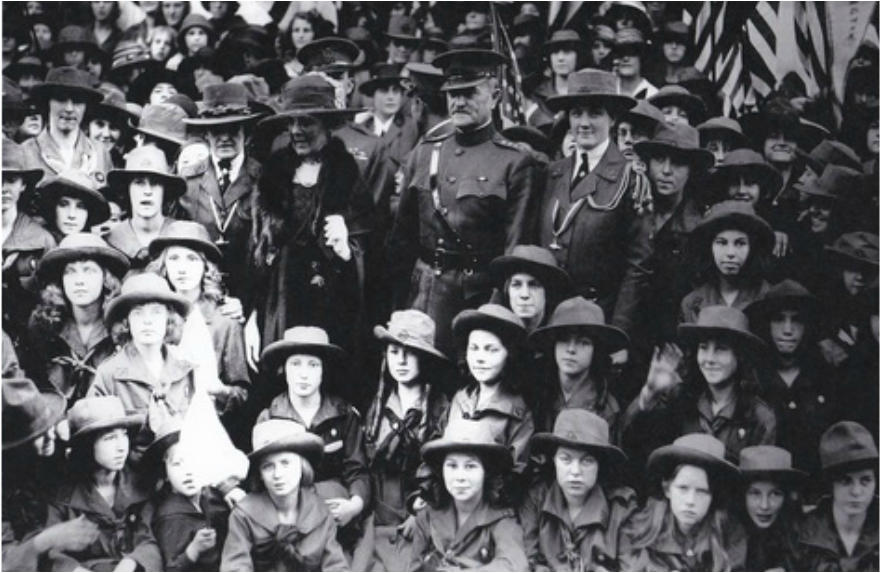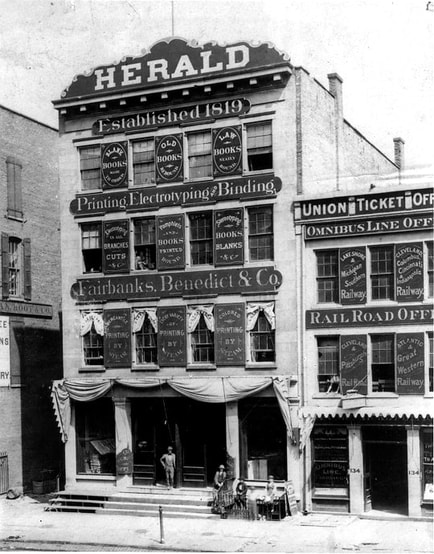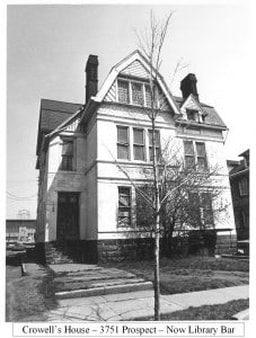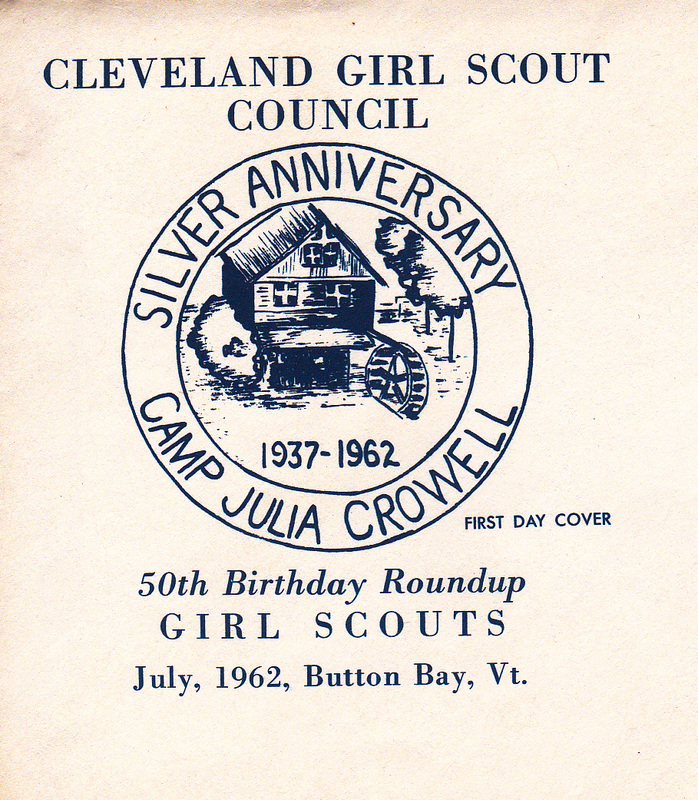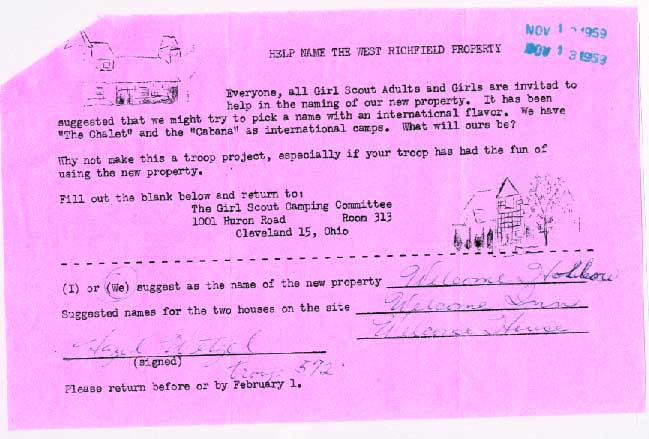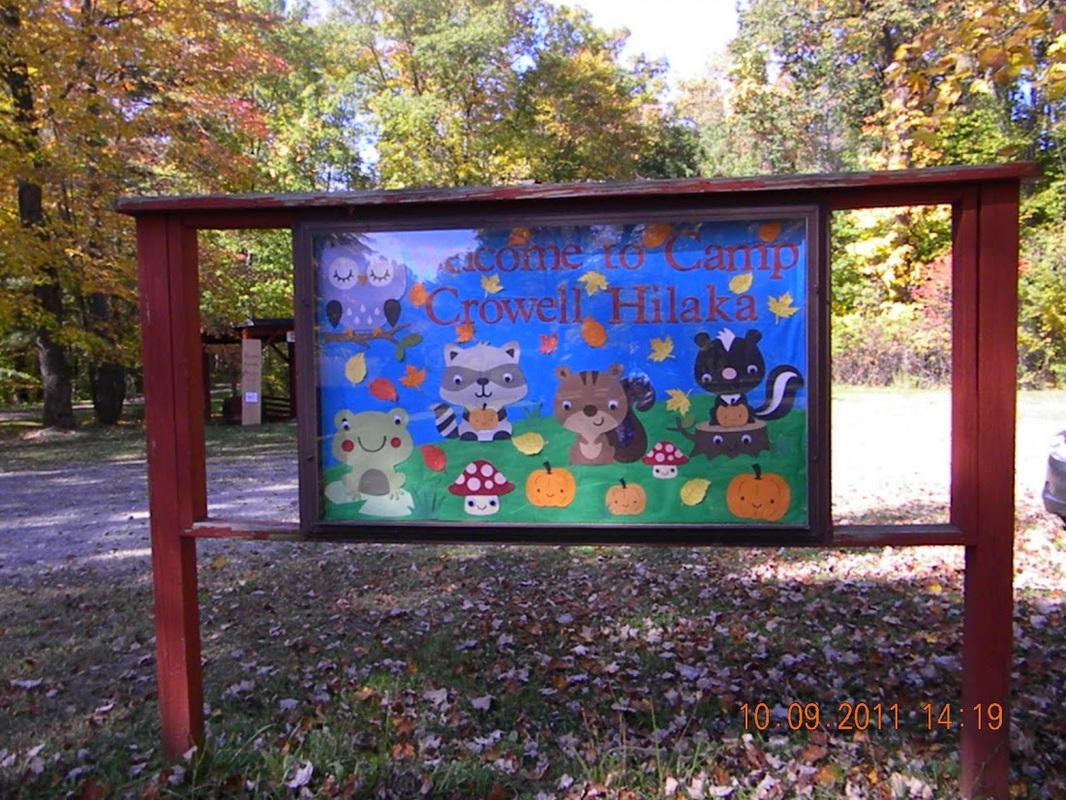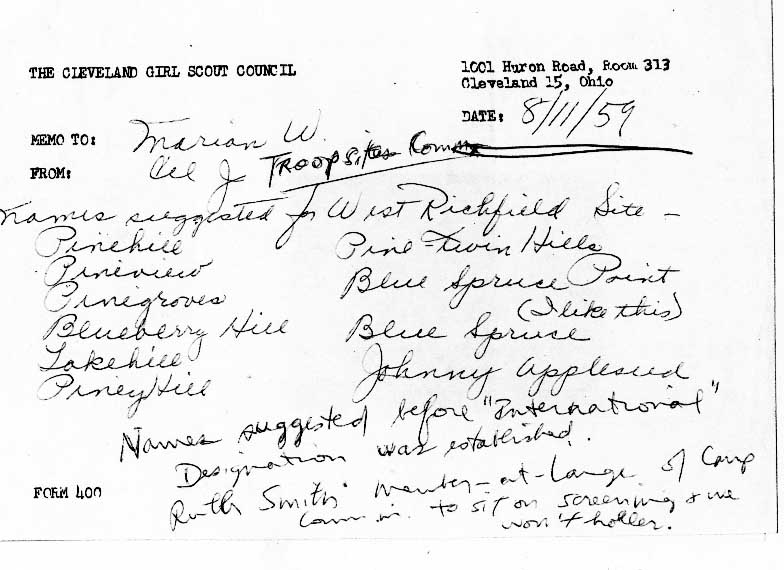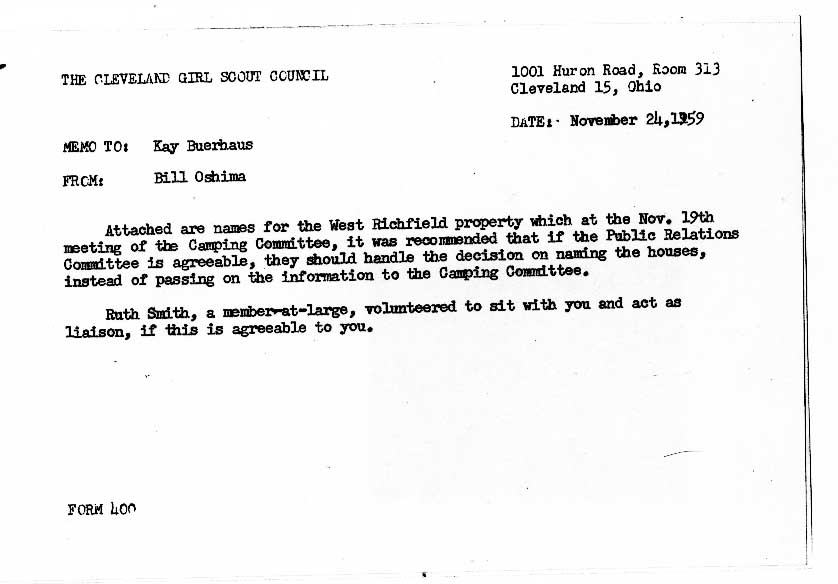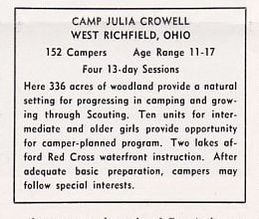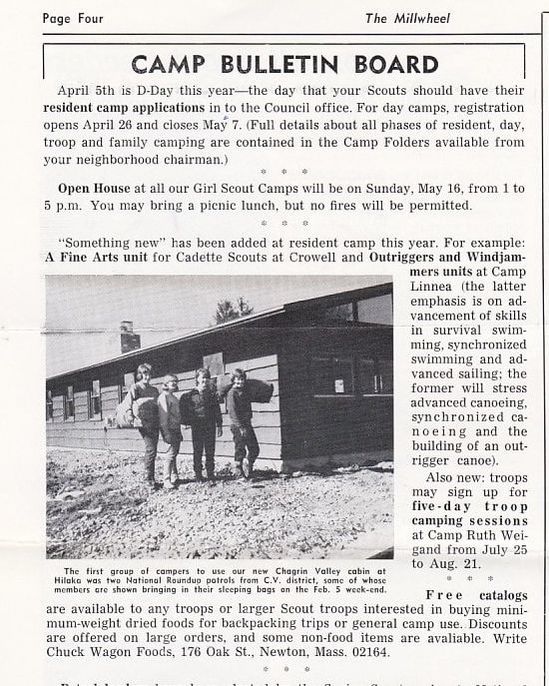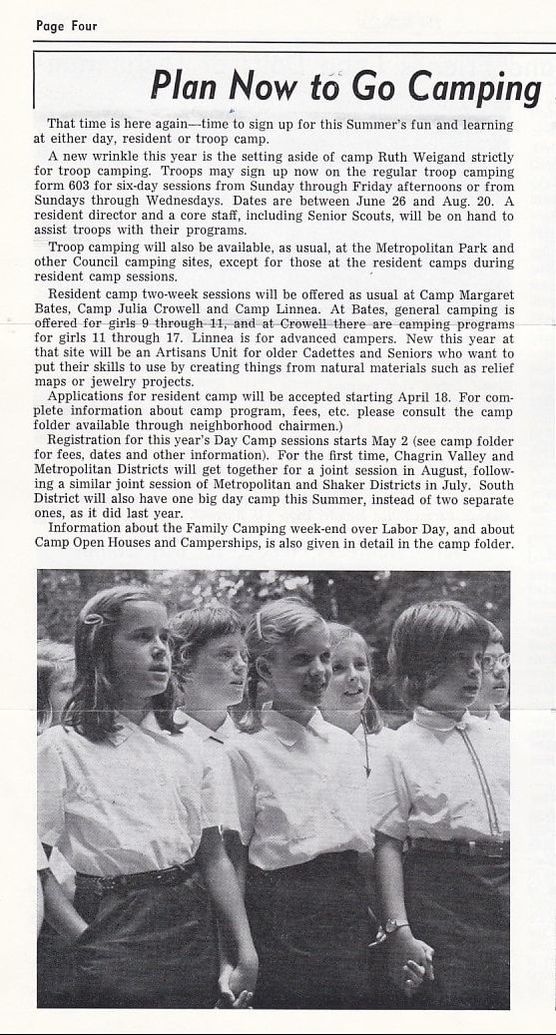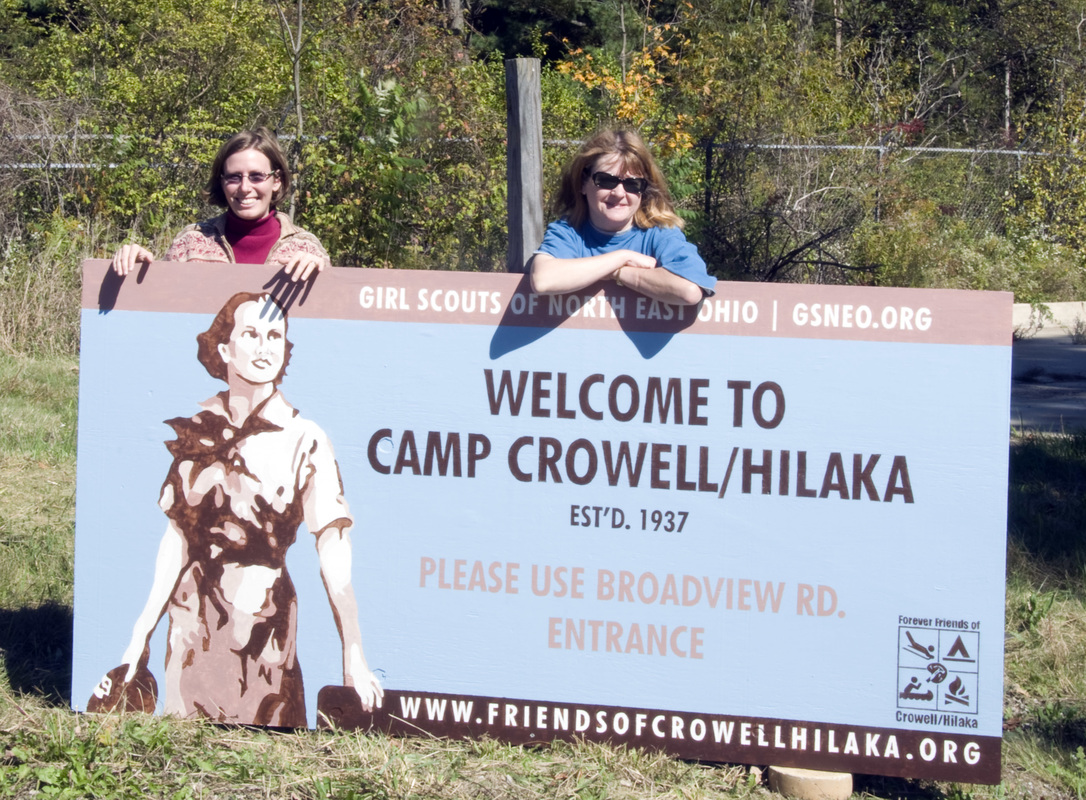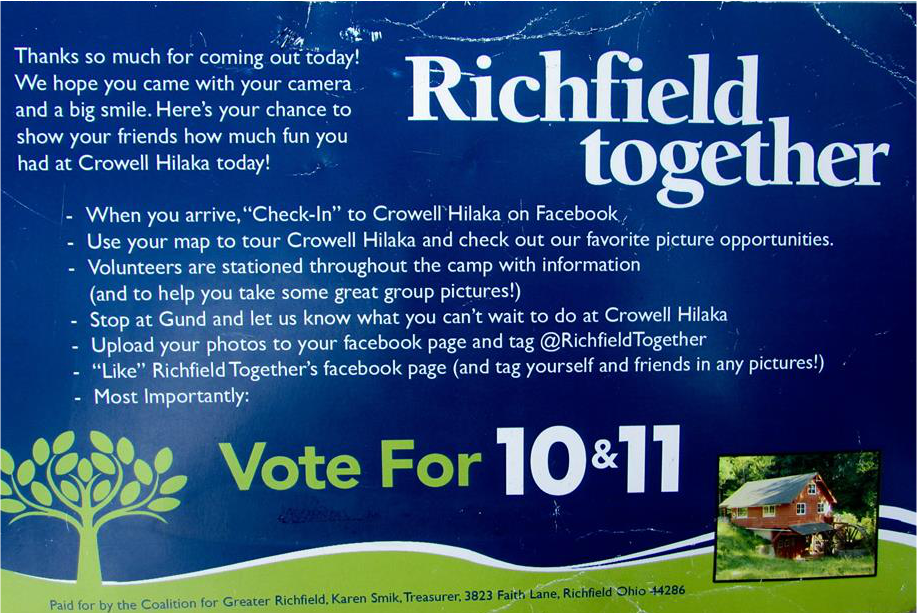WHAT'S IN A NAME?

How do you pronounce Crowell Hilaka?
Picture a crow flying well, high above a lake. Put it all together and you’ve got “Crowell Hilaka“ -emphasis on the “crow” and the “lake”.
Before leaving the subject of pronunciation, I might as well mention that Friends of Crowell Hilaka is usually abbreviated as FoCH. It rhymes with “smoke” and pronounced the same as “folk”. This is pretty convenient since FoCH is a bunch of folks who love Crowell Hilaka.
(first published in the FoCHlore blog 2015)
ORIGIN OF THE NAME 'CROWELL HILAKA' - PART 1
It was called “Camp Julia Crowell” in honor of the first commissioner of the Cleveland Girl Scouts.
Julia Root Cobb, born in 1877, grew up as a daughter of Cleveland’s “Millionaire’s Row". She played tennis, organized bicycling parties, went to finishing school in in Boston, and was properly debuted. In 1904 she married Benedict Crowell.
Benedict Crowell was a chemical engineer. Like his wife, he came from a wealthy and influential Cleveland family.
When America entered the First World War, former Cleveland mayor Newton Baker was appointed Secretary of War. Baker appointed Benedict Crowell as his Assistant Secretary. Neither was a military man. Baker was known for his administrative abilities; Crowell for his versatility and connections. When they moved to Washington their wives came with them. The ladies became involved with the newly formed Girl Scouts who were looking for ways to support the war effort. The Scouts organized lunch carts to provide food for the thousands of clerical personnel who were pouring into the city. By 1920, the two political wives from Cleveland had risen in the ranks to become the head of the Washington Girl Scouts. When the war was over they came back home to Cleveland and brought the Girl Scout organization with them.
Julia Crowell served as Commissioner of the new Cleveland Girl Scout Council from 1922 to 1928.
This essay was published in the FoCHlore blog 2/8/2015
Julia Root Cobb, born in 1877, grew up as a daughter of Cleveland’s “Millionaire’s Row". She played tennis, organized bicycling parties, went to finishing school in in Boston, and was properly debuted. In 1904 she married Benedict Crowell.
Benedict Crowell was a chemical engineer. Like his wife, he came from a wealthy and influential Cleveland family.
When America entered the First World War, former Cleveland mayor Newton Baker was appointed Secretary of War. Baker appointed Benedict Crowell as his Assistant Secretary. Neither was a military man. Baker was known for his administrative abilities; Crowell for his versatility and connections. When they moved to Washington their wives came with them. The ladies became involved with the newly formed Girl Scouts who were looking for ways to support the war effort. The Scouts organized lunch carts to provide food for the thousands of clerical personnel who were pouring into the city. By 1920, the two political wives from Cleveland had risen in the ranks to become the head of the Washington Girl Scouts. When the war was over they came back home to Cleveland and brought the Girl Scout organization with them.
Julia Crowell served as Commissioner of the new Cleveland Girl Scout Council from 1922 to 1928.
This essay was published in the FoCHlore blog 2/8/2015
ORIGIN OF THE NAME 'CROWELL HILAKA' - PART 2
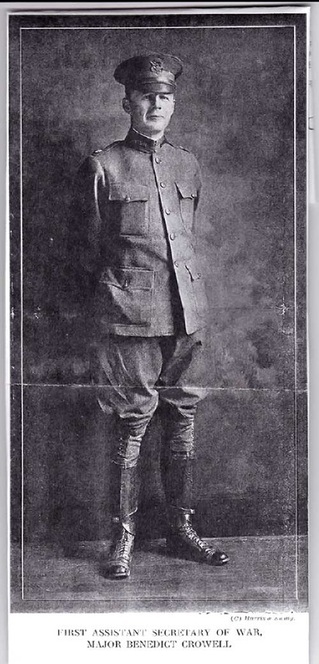
Benedict Crowell ( 1869-1952) was born in a small house on Euclid Avenue which eventually became the site of the Cleveland Arcade. “Benedict” was his mother’s maiden name.
He claimed that he studied chemistry in college because it was the easiest course that Yale offered. His first job after graduating was with the Otis Steel Company where he developed a way to analyze the phosphorus content of steel that only took twenty minutes instead of the three hour industry standard.
He began studying reinforced concrete, which led to an interest in construction. After working as a mining engineer with assignments in Alaska, Brazil, and Mexico, he launched his own construction company. He was awarded the contract to build the Cleveland Museum of Art - over the objections of the architects who wanted to hire a more experienced company. But the art museum trustees wanted someone they knew and who had local connections. Crowell successfully completed the art museum project in 1916.
He accepted an appointment to the Civil Service Commission, where he worked with Cleveland mayor Newton D. Baker. In 1916, he was placed in charge of the Washington office of the Panama Canal Zone. In 1917 he became Assistant Secretary of War. He sold his construction company and moved to Washington to organize the American manufacture of munitions and the logistics of the wartime supply chain. After the war he moved back to Cleveland and started a new construction company with his brother–in-law as his new partner. He was indicted for alleged improprieties in the awarding of government contracts, but charges were dropped for lack of evidence. He was promoted to Brigadier General. Crowell wrote several books on military mobilization and national defense preparedness. He was the president of Central National Bank from 1938 until shortly before his death in 1952.
The Crowells had two children, but no grandchildren. They established an endowment to the Cleveland Museum of Art
He claimed that he studied chemistry in college because it was the easiest course that Yale offered. His first job after graduating was with the Otis Steel Company where he developed a way to analyze the phosphorus content of steel that only took twenty minutes instead of the three hour industry standard.
He began studying reinforced concrete, which led to an interest in construction. After working as a mining engineer with assignments in Alaska, Brazil, and Mexico, he launched his own construction company. He was awarded the contract to build the Cleveland Museum of Art - over the objections of the architects who wanted to hire a more experienced company. But the art museum trustees wanted someone they knew and who had local connections. Crowell successfully completed the art museum project in 1916.
He accepted an appointment to the Civil Service Commission, where he worked with Cleveland mayor Newton D. Baker. In 1916, he was placed in charge of the Washington office of the Panama Canal Zone. In 1917 he became Assistant Secretary of War. He sold his construction company and moved to Washington to organize the American manufacture of munitions and the logistics of the wartime supply chain. After the war he moved back to Cleveland and started a new construction company with his brother–in-law as his new partner. He was indicted for alleged improprieties in the awarding of government contracts, but charges were dropped for lack of evidence. He was promoted to Brigadier General. Crowell wrote several books on military mobilization and national defense preparedness. He was the president of Central National Bank from 1938 until shortly before his death in 1952.
The Crowells had two children, but no grandchildren. They established an endowment to the Cleveland Museum of Art
And Now for the Rest of the Story…..
Benedict Crowell was the son of William Crowell and Mary Benedict.
William was a journalist and editor at The Cleveland Herald. The publisher, part-owner, and editor-in-chief of The Herald was William’s father–in-law, George Benedict. George Benedict had an illustrious career in law and public service before buying a share of The Herald. As a publisher, he was very well respected for his editorials and for allowing opposing opinions to be printed.
George’s partner at The Herald was Abel Fairbanks. Abel’s wife was Mary Mason Fairbanks. Mary corresponded frequently with Mark Twain and she was later regarded as one of the most influential women in Twain’s life.
Benedict Crowell was the son of William Crowell and Mary Benedict.
William was a journalist and editor at The Cleveland Herald. The publisher, part-owner, and editor-in-chief of The Herald was William’s father–in-law, George Benedict. George Benedict had an illustrious career in law and public service before buying a share of The Herald. As a publisher, he was very well respected for his editorials and for allowing opposing opinions to be printed.
George’s partner at The Herald was Abel Fairbanks. Abel’s wife was Mary Mason Fairbanks. Mary corresponded frequently with Mark Twain and she was later regarded as one of the most influential women in Twain’s life.
On June 3, In 1876, Mary wrote to Mark Twain: “Have you seen by the papers that our own genial, kind-hearted Mr. Benedict is dead? The papers have not told you of the double affliction of the family in the insanity (apparently hopeless) of the son-in-law Mr. Crowell. The death of the senior partner and the illness of the junior throw the entire Herald Business into Mr. Fairbanks’ hands.“
Twain replied “I received the Herald containing the news. What a curious thing life is. We delve away, through years of hardship, wasting toil, despondency; then comes a little butterfly season of wealth, ease, and clustering honors. Presto! The wife dies, a daughter marries a spendthrift villain, the heir and hope of the house commits suicide, the laurels fade and fall away. Grand result of a hard-fought, successful career and a blameless life: piles of money, tottering age, and a broken heart. My, how disasters pour when they once begin! It does seem as if Mr. Benedict’s case is about the ordinary experience, and must fairly be expected by everybody. …”
William Crowell inherited George Benedict’s share of the paper and his position as editor-in-chief in spite of whatever “insanity” there may have been. There is no mention anywhere ever again that there was a problem (at least not that I’ve found so far).
George Benedict’s widow, Sarah had a new house built after her husband's death: a beautiful brick ”Queen Anne”-style building in the affluent neighborhood of upper Prospect Avenue. She lived there until shortly before her death in 1902. After World War I, Sarah’s grandson Benedict Crowell used the house as the office of his construction company. Years passed. The neighborhood changed. Sarah’s house, close to Cleveland State University, became a popular students’ bar called “The Library”. When the bar closed, the old house stood vacant for several years. Then in 1999 Sarah Benedict’s house became the headquarters of the Cleveland Restoration Society.
Strange, how things become interconnected. So appropriate, now that we are working to preserve - and hopefully restore - the wonderful historic buildings at Crowell Hilaka: the camp named for one of Sarah’s descendants.
This essay was first published in the RJRD FoCHlore blog 2-24-2016
Twain replied “I received the Herald containing the news. What a curious thing life is. We delve away, through years of hardship, wasting toil, despondency; then comes a little butterfly season of wealth, ease, and clustering honors. Presto! The wife dies, a daughter marries a spendthrift villain, the heir and hope of the house commits suicide, the laurels fade and fall away. Grand result of a hard-fought, successful career and a blameless life: piles of money, tottering age, and a broken heart. My, how disasters pour when they once begin! It does seem as if Mr. Benedict’s case is about the ordinary experience, and must fairly be expected by everybody. …”
William Crowell inherited George Benedict’s share of the paper and his position as editor-in-chief in spite of whatever “insanity” there may have been. There is no mention anywhere ever again that there was a problem (at least not that I’ve found so far).
George Benedict’s widow, Sarah had a new house built after her husband's death: a beautiful brick ”Queen Anne”-style building in the affluent neighborhood of upper Prospect Avenue. She lived there until shortly before her death in 1902. After World War I, Sarah’s grandson Benedict Crowell used the house as the office of his construction company. Years passed. The neighborhood changed. Sarah’s house, close to Cleveland State University, became a popular students’ bar called “The Library”. When the bar closed, the old house stood vacant for several years. Then in 1999 Sarah Benedict’s house became the headquarters of the Cleveland Restoration Society.
Strange, how things become interconnected. So appropriate, now that we are working to preserve - and hopefully restore - the wonderful historic buildings at Crowell Hilaka: the camp named for one of Sarah’s descendants.
This essay was first published in the RJRD FoCHlore blog 2-24-2016
ORIGIN OF THE NAME 'CROWELL HILAKA' - PART 3
In 1937 the Cleveland Council had successfully purchased the Kirby estate. The next thing needed was a name for the new camp.
Minutes of the North East District. May 14, 1937. "Miss Cody announced that the new camp at West Richfield would be dedicated on June 20 at 3:00 p.m. and urged all her committee to be present; also that suggestions for a name for the new camp be turned in as soon as possible to the committee.
In later minutes, the property is sometimes referred to as "Main Camp" to distinguish it from long-established neighborhood camps.
But for the next twenty years, the name of the camp was unambiguously “Camp Julia Crowell”. Sometimes “CJC” for short.
In 1957, the Girl Scouts expanded the camp with the purchase of 93 adjoining acres on the north side, formerly part of the Neal Fruit Farm.
The old northern boundary of CJC ran right through the middle of Lake Linnea. The new extension gave Girl Scouts the rest of the lake. It also gave them two lakeside mansions, a carriage house, landscaped grounds, and an orchard. This opened up a realm of possibilities beyond the average camp. The most ambitious was to make the site an international destination supporting the Girl Scout World Friendship program. The World Association of Girl Guides and Girl Scouts already owned lodges in Switzerland and Mexico. Perhaps a third site could be added in Richfield, Ohio? With this in mind, the council announced a contest to name the new property with the hint that “an international name would be good".
Gleanings from reading old Millwheel newsletters:
In January of 1958, The Millwheel printed this happy announcement: "93 more! A big 93 acres has been added to Camp Julia Crowell. It includes the rest of our lovely Lake Linnea which was named for our own Linnea Friede (Mrs. Henry Friede) and has two very usable dwellings on the shores of the lake. We are looking to the future to meet our camping needs. We will all need to work doubly hard on the cookie sale this year..."
In early November of that year, a camping leadership program was held at "South House" (now Amity) on the "new West Richfield property". By January of 1959, troop camping reservations were being accepted for North House. In descriptions of summer camp, the new and old acreage together were simply called "Camp Julia Crowell."
The Jan/Feb 1960 issue featured an entry form to "Help name the West Richfield Property" with the hint: "Some have suggested an international name would be good".
Minutes of the North East District. May 14, 1937. "Miss Cody announced that the new camp at West Richfield would be dedicated on June 20 at 3:00 p.m. and urged all her committee to be present; also that suggestions for a name for the new camp be turned in as soon as possible to the committee.
In later minutes, the property is sometimes referred to as "Main Camp" to distinguish it from long-established neighborhood camps.
But for the next twenty years, the name of the camp was unambiguously “Camp Julia Crowell”. Sometimes “CJC” for short.
In 1957, the Girl Scouts expanded the camp with the purchase of 93 adjoining acres on the north side, formerly part of the Neal Fruit Farm.
The old northern boundary of CJC ran right through the middle of Lake Linnea. The new extension gave Girl Scouts the rest of the lake. It also gave them two lakeside mansions, a carriage house, landscaped grounds, and an orchard. This opened up a realm of possibilities beyond the average camp. The most ambitious was to make the site an international destination supporting the Girl Scout World Friendship program. The World Association of Girl Guides and Girl Scouts already owned lodges in Switzerland and Mexico. Perhaps a third site could be added in Richfield, Ohio? With this in mind, the council announced a contest to name the new property with the hint that “an international name would be good".
Gleanings from reading old Millwheel newsletters:
In January of 1958, The Millwheel printed this happy announcement: "93 more! A big 93 acres has been added to Camp Julia Crowell. It includes the rest of our lovely Lake Linnea which was named for our own Linnea Friede (Mrs. Henry Friede) and has two very usable dwellings on the shores of the lake. We are looking to the future to meet our camping needs. We will all need to work doubly hard on the cookie sale this year..."
In early November of that year, a camping leadership program was held at "South House" (now Amity) on the "new West Richfield property". By January of 1959, troop camping reservations were being accepted for North House. In descriptions of summer camp, the new and old acreage together were simply called "Camp Julia Crowell."
The Jan/Feb 1960 issue featured an entry form to "Help name the West Richfield Property" with the hint: "Some have suggested an international name would be good".
The following spring (1960) , the council dedicated a special issue of the newsletter to the opening ceremonies for the new Camp Hilaka. No mention was made of the contest or where the name came from.
This evidently raised a lot of questions, because in the following issue the mystery was solved on page 7 in a one-time column called "The Question Box": Q. What is the correct pronunciation of our new camp “Hilaka? Is the “a” long or short?
A. The “a” is long. Think of the HIGH LAKE (higher than the adjoining lake at Camp Julia Crowell) then add an “UH” for good measure! The Board of Directors made the final selection of the name from the many sent in. Congratulations to Mrs. Edwin H. Smith of the Camping Committee who suggested “Hilaka” - Lydia Jackson (Mrs. Wm. D) Chairman, screening committee".
Use of the new name was very fluid. In newsletters and camp director reports, the names "Camp Hilaka" and "Camp Linnea" were both used. Frequently, the full 336 acres was still collectively called Camp Julia Crowell. The 1964 summer camp notice stated there were four camps available to Lake Erie Girl Scouts: Camp Ruth Weigand, Camp Margaret Bates, Camp Linnea, and Camp Julia Crowell. Another announcement at the same time referred to a meeting to be held at Hilaka! In the March/April 1966 newsletter, a photo shows a donor presenting a check for the pool to be built at Julia Crowell. Following issues identified the same pool site…at Hilaka.
By the time I was taking troops camping in the 1980s, it was common to refer to renting a campsite either at Crowell OR at Hilaka. The gas cut was understood to the boundary between the two. But if the whole property was being used for a single program such as summer resident camp or the Cadette/Senior Summit, it was called “Crowell Hilaka”.
In 2009 the newly merged mega-council GSNEO was evaluating its property portfolio. A properties consultant from GSUSA recommended that they keep Camp Hilaka for arts programs since girls liked the historic buildings, but to sell Crowell. The newly-formed Friends of Crowell Hilaka decided we needed to stop talking about separate “sides” of the camp and always call it by its full name. We hoped that The Powers That Be would recognize the entire property was a magical place that should not be divided.
This evidently raised a lot of questions, because in the following issue the mystery was solved on page 7 in a one-time column called "The Question Box": Q. What is the correct pronunciation of our new camp “Hilaka? Is the “a” long or short?
A. The “a” is long. Think of the HIGH LAKE (higher than the adjoining lake at Camp Julia Crowell) then add an “UH” for good measure! The Board of Directors made the final selection of the name from the many sent in. Congratulations to Mrs. Edwin H. Smith of the Camping Committee who suggested “Hilaka” - Lydia Jackson (Mrs. Wm. D) Chairman, screening committee".
Use of the new name was very fluid. In newsletters and camp director reports, the names "Camp Hilaka" and "Camp Linnea" were both used. Frequently, the full 336 acres was still collectively called Camp Julia Crowell. The 1964 summer camp notice stated there were four camps available to Lake Erie Girl Scouts: Camp Ruth Weigand, Camp Margaret Bates, Camp Linnea, and Camp Julia Crowell. Another announcement at the same time referred to a meeting to be held at Hilaka! In the March/April 1966 newsletter, a photo shows a donor presenting a check for the pool to be built at Julia Crowell. Following issues identified the same pool site…at Hilaka.
By the time I was taking troops camping in the 1980s, it was common to refer to renting a campsite either at Crowell OR at Hilaka. The gas cut was understood to the boundary between the two. But if the whole property was being used for a single program such as summer resident camp or the Cadette/Senior Summit, it was called “Crowell Hilaka”.
In 2009 the newly merged mega-council GSNEO was evaluating its property portfolio. A properties consultant from GSUSA recommended that they keep Camp Hilaka for arts programs since girls liked the historic buildings, but to sell Crowell. The newly-formed Friends of Crowell Hilaka decided we needed to stop talking about separate “sides” of the camp and always call it by its full name. We hoped that The Powers That Be would recognize the entire property was a magical place that should not be divided.
Change is in the very nature of language. But change happens for reasons. I am especially intrigued by the early discrepancy in the name of the north 93 acres: sometimes Hilaka, sometimes Linnea, sometimes nothing at all - just part of CJC. Was there some hidden power struggle going on? Between who? And why? We may never know.
Names can be a powerful way to influence thinking. Maybe it would have been simpler in 1957, Cleveland Girl Scouts would have acknowledged they were enlarging CJC without re-naming a piece of it or trying to create an identity for a "new" camp.
Names can be a powerful way to influence thinking. Maybe it would have been simpler in 1957, Cleveland Girl Scouts would have acknowledged they were enlarging CJC without re-naming a piece of it or trying to create an identity for a "new" camp.
The following three clippings from The Millwheel 1964 - 1966 show the new part of the camp identified as "Camp Linnea" even though it had been dedicated as "Hilaka" in June of 1960.
The Millwheel identified "Linnea" as an alternative name for Camp Julia Crowell in a notice about the newly appointed summer camp directors for 1972:

